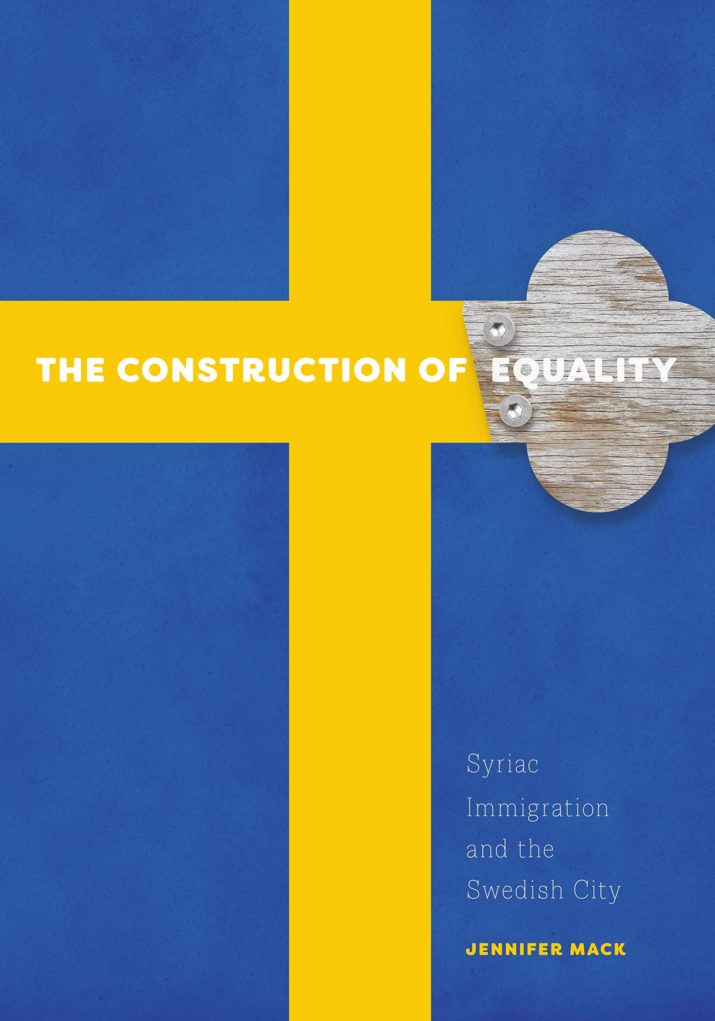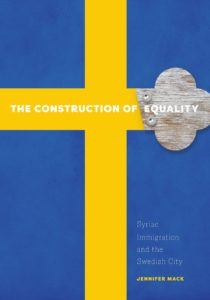
This is part of our special feature on Anxiety Culture.

Jennifer Mack’s The Construction of Equality, tells the fascinating story of a community of Syriac Orthodox refugees in Sweden who fled discrimination and persecution in Turkey and lived as stateless refugees in Lebanon before being admitted by Swedish authorities as part of a quota agreement in 1967. From these 205 founding fathers, the community grew over the years to the present number of around 8,000 Orthodox Christians from the Middle East, the majority of whom are Syriacs. The story is about how this community managed to transform the geographical and social environment of the small Swedish town of Södertälje and its outskirts from a welfare state environment, planned from above, to a relatively ethnically-segregated Syriac suburb.
Mack’s background is architecture, urban planning, and anthropology, and she aims to describe the development of what she calls “urban planning from below” in contrast to what she sees as a monolithic, equality-ridden, and difference-defying Swedish urban planning regime. She bases her story and analysis on what she terms an interdisciplinary method, including ethnographic approaches and participant observation, paired with formal analysis and archival research of planning documents for the development of Södertälje and its surroundings. The ethnographic research involved, among other things, fifty interviews with city planners and additional interviews with Syriac citizens in different positions in the community. She also conducted formal analysis of the built environment to trace changes to spaces over time, as well as of the media discourse on these changes in local Swedish and Syriac newspapers. The aim of the book is well-outlined in the last sentence of the preface: “The design, construction, and use of Syriac spaces in Södertälje suggest that it is high time to rethink current understandings of segregation and how architecture and planning really happen in twenty-first-century Europe (xii).”
According to the introduction, the book’s main objective is to analyze the relatively peaceful confrontation between a Swedish social democratic, industrialized welfare state in full blossom, and an orthodox Christian minority group that more than anything else wanted to recreate their previously segregated Middle Eastern community model in Sweden. The introduction goes on to present Swedish urban planning as an expression of welfare-state ideology, the objective of which was to redefine Swedish citizenship by constructing the environment as breeding ground of equality, understood as sameness. The author challenges this Swedish welfare state approach and asks how alternative public spheres have evolved over time and conflicted with, or expanded, notions of public space, and how ideas of equality and difference are generally resolved in cities. She further claims to focus her investigation on how urban planners, architects, and builders have produced urban space through conflict and collaboration in spite of different agendas. The claim is that urban planners have seen difference as a main challenge to the equality they wished to promote through social housing programs. This is especially salient in Sweden, where social housing, and the construction of uniform housing structures, became a strategy for forming new, equal social welfare state subjects. Thus, the segregated urban spaces the Syriacs preferred not only vexed urban planners, but also became what the author describes as “their nightmare of segregation.” According to Mack, any effort to create “urban designs from below” or incorporate public voices, including immigrants’, in urban planning has at best resulted in disappointment on both sides.
Following the Introduction, Mack’s first chapter focuses on the so-called “Million Program,” which was a leading model for urban planning and the solution to serious shortage of housing in Sweden following World War II. The program’s aim was to build one million new dwellings for the growing population. Mack discusses the program and its perceived shortcomings in relation to the changing demographics of Sweden in the late 1960s. During that time, Sweden evolved from a relatively ethnically homogeneous society to a developing multicultural one. Mack argues that the Swedish welfare state, through its architectural layouts and models, sought to create social equality though sameness and uniformity. The integration regime in Sweden, as in the other Scandinavian welfare states, was, at that time, based on the ideal of multiculturality and integration: migrants were encouraged to keep and develop their cultural trait, while adhering to Swedish norms and expectations of “invisibility.” To achieve this end, the Swedish government spread small groups of migrants of the same nationality or ethnicity all over Sweden to avoid the development of segregated neighborhoods.
According to the author, this did not concur with the historical experiences of the Syriacs. Their experience as a persecuted religious and ethnic minority without a proper homeland, living close together in segregated villages for security and cultural survival, made Swedish models of dwelling unfamiliar and undesirable. This clash between the interests, traditions, and norms of Swedish integration and housing policies, on the one hand, and those of Syriac migrants in developing urban spaces, on the other, collided with “Sweden’s international reputation as an ideal place for asylum seekers and immigrants…damaging not only…the reputation of the projects themselves but…the self-image of the country” (3).
In Chapter 2, Mack discusses the development of the neighborhoods in Södertälje created by the Million Program and left by majority Swedes in the 1970s following the economic crisis. These neighborhoods were eventually taken over by thousands of Syriac migrants who moved from all over Sweden due to the wish to live together and develop a Syriac environment. From the 1980s onward, Syriacs actively adapted spaces established for welfare-state institutions, changing them into nationalist and Orthodox Syriac spaces. Chapter 3 continues the story by describing the process of changing the built environment from a profane welfare-state utopia into a diasporic space, at once sacred and profane—a Syriac homeland in Sweden. This transformation started with the erection and slow transformation of Syriac Orthodox churches, through negotiations with Swedish officials and Swedish building regulations. Mack also details the split of the Syriac community into two rather antagonistic religious communities, ‘Syrianer’ and ‘Assyrer’, based on different religious and historical interpretations, with separate churches and corresponding soccer fields, established during the 1980s.
In Chapter 4, Mack describes the spatial practices, including rituals such as weddings and funerals, norms of proper bodily conduct, dress, and proper ritual performances, and new physical structures that allow Syriac citizens to preserve and develop their community. The chapter very subtly refers to one of the oft-cited problems experienced in tight, segregated communities—the strong social control, especially of young women. Although this problem is not discussed in depth, the reader comes to understand that not all Syriacs see Södertälje as “their city.” Chapter 5 details the liberalization of the Swedish collective housing program and the growing demand for single-family houses among Swedes in general. The chapter tells the story of how Syriacs, who had achieved considerable social mobility during the 1990s, managed to buy plots allotted by the local government and, in a long-lasting process of conflict and cooperation with Swedish housing authorities, develop new neighborhoods consisting of Syriac extended families. This development and the new Syriac-dominated neighborhoods have apparently required planners to rethink their understanding of the link between poverty and ethnic segregation and to see the importance of including citizens in urban planning.
Chapter 6 focuses on the standardization of Swedish urban planning and the extent to which diverging styles, tastes, and forms are allowed to appear in the city. The Syriac-segregated neighborhoods were designed in accordance with general building regulations, but the use of foreign materials and ornamentation makes them “outlandish.” Mack writes, ‘”This architecture of difference uses imported materials and innovative appearances that have thereby become metaphors for debates about nationalism and citizenship” (17). A Syriac entrepreneur, arguing for Syriac building stones, offers the following reasoning: “First and foremost, there are no beautiful stones in Sweden, and the ones they have are expensive. They only have ordinary stones in Sweden, just reddish, coarse stones (260).” Mack concludes her story by stating that the concentration of Syriacs and the development of Swedish geographical spaces into Syriac environments is an example of the intersection of top-down and bottom-up urban planning, whereby users become planners and designers. This conclusion gives credit somehow to the flexibility and cooperative efforts of what is portrayed elsewhere as an inflexible welfare state and its agents. She further advocates this top-down/bottom-up approach for urban planners all over Europe, claiming to “point the way forward to understanding how enclaves may be a productive force in the future of European societies and cities” (18).
The Construction of Equaity is an interesting and thought-provoking study that engages its problem with both a broad overview and great detail. It is extremely well-written, and each chapter deepens the reader’s understanding of the Syriac community’s ability to negotiate its interests vis-a-vis majority urban planners and housing regulations in Södertälje. Having read it as a social anthropologist, interested—though not particularly trained in—urban planning, I find the book raises many questions. I will concentrate on three of them here.
My first objection is to the author’s general representation of the Swedish welfare state and its institutions, especially the Swedish housing regime. Where she presents the development of Syriac Södertälje as a battle against an inflexible, slightly nationalistic and xenophobic, universalist welfare state, I see two “ethnic” entities: the Swedish majority, represented by public agencies; and a Syriac minority, negotiating the boundary between Swedishness and Syriacness. I also see a debate over how these identities should be physically and socially represented. The structural power relations between the two entities are obviously imbalanced, but as a minority, the Syriac migrants are not powerless. Whereas state agencies can rely on regulations, laws, and law enforcement to secure their interests, the Syriac minority has the moral power vested in minorities in general through the policy of multiculturalism/integration that promises minorities the right to develop their culture, language, and traditions inside the boundaries of Swedish law, regulations, and norms. Moreover, from this reader’s point of view, both parties have similar interests: to uphold the boundaries protecting their worldview and way of life. The Swedish society promotes its interests through its integration regime, whereby non-Swedish citizens (refugees) are spread across the country to avoid ethnic enclaves that could threaten the Swedish ideal of equality as social sameness. The Syriacs, on the other hand, struggle to maintain their lifeworld by closing ranks and creating a “Syriacs only” space, in which equality is equated with ethnic sameness. Instead of seeing the development of “Mesopotälje” as an uneven confrontation and a negotiation for two different ways of ordering social and geographical space, I cannot help but read this narrative as a “battle cry” against the Swedish welfare state, represented by its integration regime and the Million Program of the 1960s–80s.
My second objection is that the presentation of both these programs is rather ironic and normative. As much as I support critical approaches to state governance, and especially to integration regimes, critical analysis should be grounded on solid empirical data, which are lacking in this text. Instead, we find a series of slogans and accusations that are not well grounded empirically. For example, in a passage about ethnicity superseding earlier discourses on race in Sweden, Mack writes,
“Though the philosophy of integration allowed more room for alternative lifestyles, it nonetheless simultaneously reified cultural expectations, a theme often seen in relation to so-called immigrant-dense suburbs. In Sweden in other words, the philosophy of integration has created what anthropologist Paul Silverstein [writing about immigration policies in Germany] terms a ‘new savage slot’; it has opened and closed to define Others” (68).
But what are the other aspects of the integration regime of what Mack portrays as an “alluring” and “failed” welfare state? The ideal of equality was based on the battle to eradicate class-based poverty in Sweden and to compensate for inequalities caused by social, economic, ethnic, or physical conditions. Did Syriac refuges not also receive subsidized housing, free language training, affordable kindergartens for their children, and free schools and medical assistance like other Swedes? Is their success in Sweden not due, at least partly, to a supportive welfare state?
My last objection refers to the lack of statistical and ethnographic data supporting the book’s rather jubilant celebration of the Syriac enclaves. It would, for instance, be interesting to know more about the ethnographic features of the Syriac enclaves, such as the percentage of Syriacs who live in them, their socio-economic conditions, unemployment and crime rates. It would also be interesting to know something about the internal power structures of these enclaves, which are only very briefly discussed in the chapters about the internal division of the community. And most importantly, what do Syriacs outside the enclaves and non-Syriac neighbors think about them?
These rather critical comments notwithstanding, I enjoyed The Construction of Equality and can recommend it to scholars interested in urban planning in a multicultural environment like Sweden. Its approach to the Swedish welfare state, social democratic urban planning, and basic ideas on migration policies is thought-provoking and raises many important questions about the balance between equality and difference, individuality and belonging, and different interpretations of equality, as well as about minority-majority cohabitation.
Reviewed by Ada Engebrigtsen, Oslo Metropolitan University
The Construction of Equality: Syriac Immigration and the Swedish City
By Jennifer Mack
Publisher: University of Minnesota Press
Hardcover / 344 pages / 2017
ISBN: 978-0816698714
To read more book reviews, please click here.
Published on July, 2 2018.




